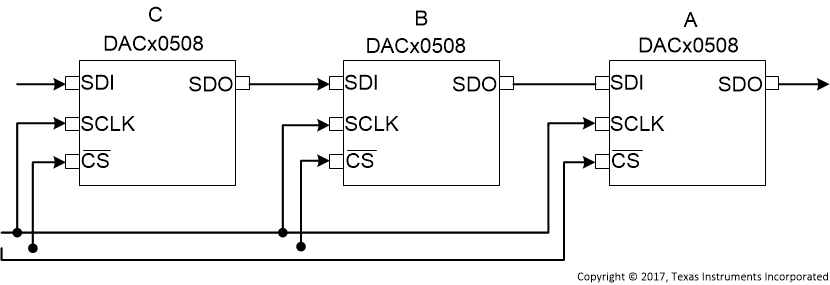JAJSE84D June 2017 – August 2018 DAC60508 , DAC70508 , DAC80508
PRODUCTION DATA.
- 1 特長
- 2 アプリケーション
- 3 概要
- 4 改訂履歴
- 5 概要(続き)
- 6 Device Comparison Table
- 7 Pin Configuration and Functions
- 8 Specifications
-
9 Detailed Description
- 9.1 Overview
- 9.2 Functional Block Diagram
- 9.3 Feature Description
- 9.4 Device Functional Modes
- 9.5 Programming
- 9.6
Register Map
- 9.6.1 NOP Register (address = 0x00) [reset = 0x0000]
- 9.6.2 DEVICE ID Register (address = 0x01) [reset = 0x---]
- 9.6.3 SYNC Register (address = 0x2) [reset = 0xFF00]
- 9.6.4 CONFIG Register (address = 0x3) [reset = 0x0000]
- 9.6.5 GAIN Register (address = 0x04) [reset = 0x---]
- 9.6.6 TRIGGER Register (address = 0x05) [reset = 0x0000]
- 9.6.7 BRDCAST Register (address = 0x6) [reset = 0x0000]
- 9.6.8 STATUS Register (address = 0x7) [reset = 0x0000]
- 9.6.9 DACx Register (address = 0x8 to 0xF) [reset = 0x0000 or 0x8000]
- 10Application and Implementation
- 11Power Supply Recommendations
- 12Layout
- 13デバイスおよびドキュメントのサポート
- 14メカニカル、パッケージ、および注文情報
パッケージ・オプション
メカニカル・データ(パッケージ|ピン)
サーマルパッド・メカニカル・データ
- RTE|16
発注情報
9.4.2 Daisy-Chain Operation
For systems that contain more than one DACx0508 devices, the SDO pin can be used to daisy-chain them together. Daisy-chain operation is useful in reducing the number of serial interface lines.
The first falling edge on the CS pin starts the operation cycle. If more than 24 SCLK pulses are applied while the CS pin is kept low, the data ripples out of the shift register and is clocked out on the SDO pin either on the falling edge or rising edge of SCLK according to the FSDO bit. By connecting the SDO output of the first device to the SDI input of the next device in the chain, a multiple-device interface is constructed. Each device in the system requires 24 clock pulses. As a result the total number of clock cycles must be equal to 24 × N, where N is the total number of DACx0508 devices in the daisy chain. When the serial transfer to all devices is complete the CS signal is taken high. This action transfers the data from the serial peripheral interface (SPI) shift registers to the internal registers of each device in the daisy chain and prevents any further data from being clocked into the input shift register.
 Figure 64. Daisy-Chain Layout
Figure 64. Daisy-Chain Layout